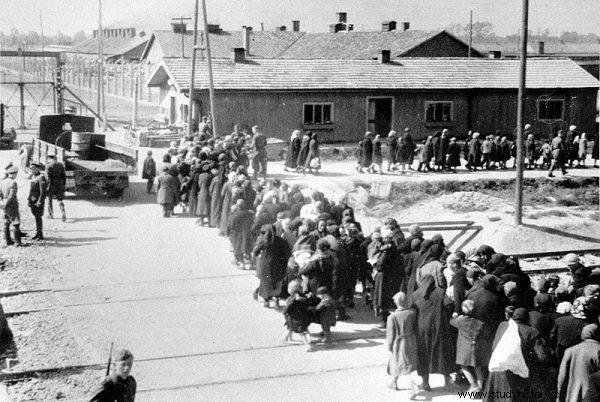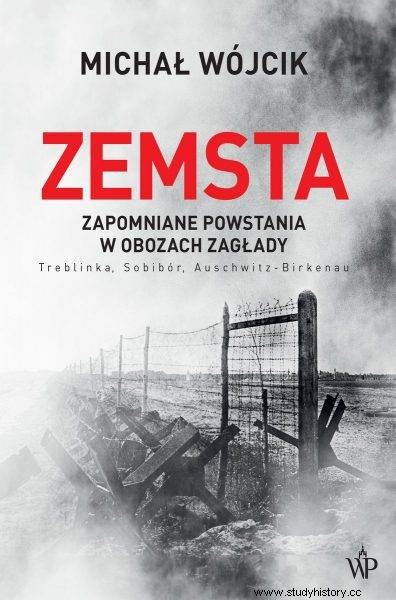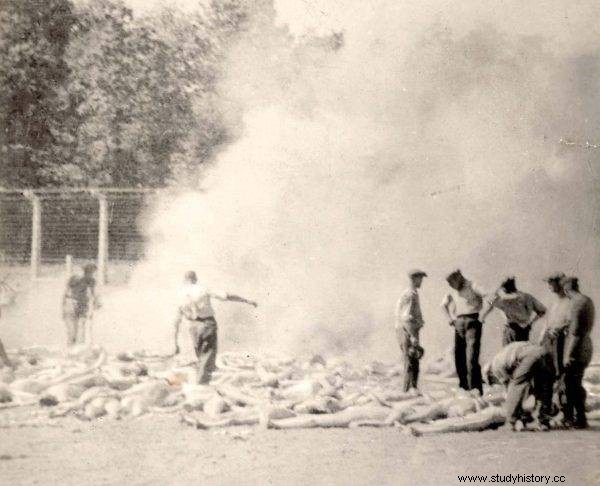On October 7, 1944, the largest prisoner revolt in the history of the camp took place in Auschwitz-Birkenau. The Jews from the Sonderkommando set fire to and seriously damaged one of the crematoriums, and attacked the SS men with stones, axes and hammers. Some insurgents managed to get out of the barbed wire, but they had to pay the highest price for it. About 250 of them died. How did this spurt come about?
It was Saturday, October 7th. It was a warm and sunny day. There was terrible news in the morning. On the same day, the SS will make another selection in the Sonderkommando. Of course, traditionally, the SS said that the chosen ones were to be sent to another section and nothing bad would happen to them ...
Immediately after this announcement, the leaders of the plot met for the last time. How great the tension and disorientation was, let the split that took place then. The prisoners split up again. The selection was to concern crematorium IV and V, while the remaining warehouses were to be spared. Since the Sonderkommando was still under pressure that the Home Army would liberate the camp at any moment, it is likely that those from crematoria II and III had broken away. They decided to wait out the selection and stick to the old plan.
This is suggested by, among others historian Igor Bartosik. In his opinion, it was agreed that - and I quote: "... as long as the selected fight the SS, they will have to count on themselves" . This would mean that the leaders of the rebellion ruled out the use of grenades in their possession. Such explosions would expose a conspiracy. But does such a scenario make sense? Although Lewental wrote about these hesitations, he honestly admitted that he did not know the details and that the Soviet comrades had already made their decision.
Password to attack
Exactly, what about them? It is known that out of the nineteen prisoners of war who came from Majdanek, nine worked in crematorium II on a daily basis, and the rest in crematorium III. What about "Comrade Siom" and the rest? After all, they were to be the main driving force behind the rebellion, and they prepared the explosives together with the "Greeks". And it was they who announced that they would launch an attack no matter what. They were waiting for now. It's hard to imagine what they must have felt when suddenly, a dozen or so minutes after 1pm, cars with SS men arrived at Crematorium IV.
“They ordered the Antreten zum Appell! (Line up for the roll call). It was clear what they were going to do, wrote Leon Cohen. A total of three hundred and sixteen prisoners stood up for the roll call. The vast majority were from Hungary, only a few were from Greece. The SS men separated several dozen prisoners from them, who were responsible for the constant readiness of the crematorium to work, and finally two hundred and eighty-six remained in the square. Then the selection started.

Altogether, three hundred and sixteen prisoners stood up for the roll call. The vast majority were from Hungary, only a few were from Greece (illustrative photo).
Everyone in the square knew what that meant. “When the Greeks of the Sonderkommando heard this order, they immediately gave the password to attack. This is how the rebellion began ” Leon Cohen continued. He was Greek, so no wonder he focused on his fellow countrymen. Yet they were not the first to attack. Chaim Neuhoff from Sosnowiec, 54, turned out to be desperate. When a passing SS man selected him to die, he reached for a hidden hammer and threw himself on it. He shouted:"Hurray!".
That was the attack password. At this point, the others started the attack. The prisoner Filip Müller remembered it a little differently. Unlike Cohen, he was there personally. He stood in a row and witnessed the reading of numbers. Since his was the shortest, he stood paralyzed with fear and watched everything to the end. At one point, the SS men realized that a dozen or so of the called were missing. When they went to the crematorium building, rightly suspecting that the prisoners were hiding there, stones fell on their heads.
"We injured 12 Germans"
Then they opened fire. First they fired blindly, then they managed to organize themselves. Their fury was violent, but the conspirators were soldiers too. If not all of them, surely some of them knew what to do. “They put up a heroic resistance and did not allow themselves to be led out of the square. They made a huge uproar, attacked the guards with hammers and axes, wounded some of them; the others beat them whatever they could, threw stones at them (...). It lasted only a few moments, and a whole squad of SS men armed with machine guns and hand grenades arrived. Our people, seeing that everything was lost, set fire to the crematorium, there was a frenzy and a shooting "- wrote Lewental.
But he was not in the square then either. He was next door, in the 3rd crematorium. The only witnesses who saw the fight with their own eyes (they survived, and then they gave an account) were Müller, as well as Abraham and Szlama Dragons and Henryk Tauber.

The text is an excerpt from Michał Wójcik's book “Zemsta. Forgotten uprisings in the extermination camps:Treblinka, Sobibór, Auschwitz-Birkenau ”, which has just been published by Wydawnictwo Poznańskie. Buy now "
"We injured 12 Germans," reported Szlama. "There were probably two or three killed." . While the fight was going on outside, some of the prisoners ran inside. Here was a hidden arsenal, here were explosives . The easiest way was to set the mattresses on fire. The fire was to be set by Jossel (Warszawski?), Because, according to Eisenschmidt, he was in command here. “He was the first to set the fire. At first they must have set fire to the bunks, mattresses and roof trusses. Where the prisoners lived. It was a sign to start a rebellion. ”
Nothing to lose
Some of the insurgents ran upstairs. Probably from there the Germans started to bite back. Is it effective? What can a stone, even a knife, do against a firearm? The siege lasted for a few or a dozen minutes. Not all of them took part in the fight. The kapo of Crematorium V, Szlomo Kirszenbaum, persuaded the Germans to let him and the prisoners under his control leave their building. Thanks to this, he saved about one hundred or one hundred and twenty people. Not for long ... Meanwhile, Szlama - just like in some comedy of errors - was busy with something else. Either he couldn't or didn't want to get into his thirty grenades! He ran away in a different direction, away from the crematorium.
" I was afraid that those hidden in the wall would explode and that way the Germans would learn about the existence of the organization. Fortunately, the wooden roof collapsed, burying the living quarters beneath it. Thanks to this, the SS men could not discover anything ”. What was he talking about ?! After all, the SS men had to find out. They were supposed to feel these explosions on their own skin. May it be as painful as possible! Could Dragon thus confirm the split among the prisoners? Or maybe the situation just overwhelmed him. After all, he and his brother were civilians.

Members of the Sonderkommando burning the bodies of Hungarian Jews murdered in the gas chambers of Auschwitz-Birkenau
"We didn't know which direction to go," explained Abraham. “The most important thing is to get away. The Germans started shooting and hit some of us. We ran on. There were actually only two exits:towards Crematorium V or towards camp street. ”
Therefore, it seems that for some of the conspirators the matter was a sealed one. Brutal calculation won. What was happening now in the yard of Crematorium IV was not yet an actual uprising. Dragon already knew about it. Even though he was aware of the terrible situation of his comrades, he did not go to the grenades. He left everything behind and ran away . Just to go into battle another day. But not everyone did what he did. Some did not run away. Others were eager to fight. After all, they had what. They were as determined as Neuhoff. Or perhaps, as the German historian Andreas Kilian suggests, they had nothing to lose. After all, they had lost everything before:their loved ones, homes, and the meaning of life. What else is left for them?
Source:
The text is an excerpt from Michał Wójcik's book “Zemsta. Forgotten uprisings in the extermination camps:Treblinka, Sobibór, Auschwitz-Birkenau ", which has just been published by Wydawnictwo Poznańskie.
